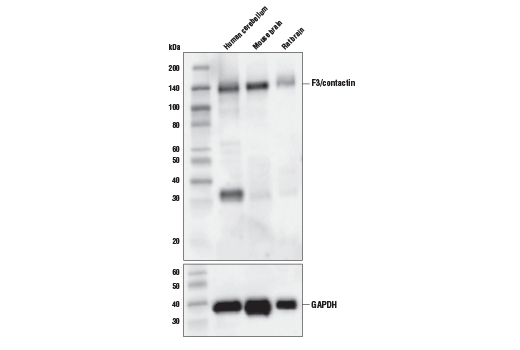WB
H M R
Endogenous
140
Rabbit IgG
#Q12860
1272
Product Information
Product Usage Information
| Application | Dilution |
|---|---|
| Western Blotting | 1:1000 |
Storage
Specificity / Sensitivity
Species Reactivity:
Human, Mouse, Rat
Source / Purification
Monoclonal antibody is produced by immunizing animals with a synthetic peptide corresponding to residues surrounding Met774 of human F3/contactin protein.
Background
F3/contactin (CNTN, contactin 1) is a glycosylphosphatidylinositol (GPI)-anchored neural cell adhesion protein belonging to the immunglobulin protein superfamily (1). During early mammalian development, F3/contactin is expressed in granule neuronal progenitor (GNP) cells, where it was shown to promote GNP differentiation, in part by antagonizing sonic hedgehog (SHH)-mediated proliferation (2). Biochemical studies have shown that F3/contactin interacts with the phosphatase PTPRZ on the surface of oligodendrocyte precursor cells, an association that was shown to be essential for oligodendrocyte maturation (3). F3/contactin expression is also abundant in post-mitotic neurons, where its functions as a neural cell adhesion protein have been suggested to play an important role in synaptic plasticity and memory (4). Although primarily associated with neuronal development and function, F3/contactin expression has also been implicated in extra-neuronal tumorigenesis. For example, expression of F3/contactin was detected in both primary prostate tumors, and lymph node and bone metastases, while patient tumor samples with detectable F3/contactin expression were associated with tumor progression and reduced recurrance-free survival (5).
Species Reactivity
Species reactivity is determined by testing in at least one approved application (e.g., western blot).
Western Blot Buffer
IMPORTANT: For western blots, incubate membrane with diluted primary antibody in 5% w/v nonfat dry milk, 1X TBS, 0.1% Tween® 20 at 4°C with gentle shaking, overnight.
Applications Key
WB: Western Blotting
Cross-Reactivity Key
H: human M: mouse R: rat Hm: hamster Mk: monkey Vir: virus Mi: mink C: chicken Dm: D. melanogaster X: Xenopus Z: zebrafish B: bovine Dg: dog Pg: pig Sc: S. cerevisiae Ce: C. elegans Hr: horse GP: Guinea Pig Rab: rabbit All: all species expected
Trademarks and Patents
Limited Uses
Except as otherwise expressly agreed in a writing signed by a legally authorized representative of CST, the following terms apply to Products provided by CST, its affiliates or its distributors. Any Customer's terms and conditions that are in addition to, or different from, those contained herein, unless separately accepted in writing by a legally authorized representative of CST, are rejected and are of no force or effect.
Products are labeled with For Research Use Only or a similar labeling statement and have not been approved, cleared, or licensed by the FDA or other regulatory foreign or domestic entity, for any purpose. Customer shall not use any Product for any diagnostic or therapeutic purpose, or otherwise in any manner that conflicts with its labeling statement. Products sold or licensed by CST are provided for Customer as the end-user and solely for research and development uses. Any use of Product for diagnostic, prophylactic or therapeutic purposes, or any purchase of Product for resale (alone or as a component) or other commercial purpose, requires a separate license from CST. Customer shall (a) not sell, license, loan, donate or otherwise transfer or make available any Product to any third party, whether alone or in combination with other materials, or use the Products to manufacture any commercial products, (b) not copy, modify, reverse engineer, decompile, disassemble or otherwise attempt to discover the underlying structure or technology of the Products, or use the Products for the purpose of developing any products or services that would compete with CST products or services, (c) not alter or remove from the Products any trademarks, trade names, logos, patent or copyright notices or markings, (d) use the Products solely in accordance with CST Product Terms of Sale and any applicable documentation, and (e) comply with any license, terms of service or similar agreement with respect to any third party products or services used by Customer in connection with the Products.
